NYT 8:05*
LAT 7:40
Reagle 6:31
Hex/Hook 10:34 (pannonica)
WaPo 12:07 (Neville)
CS 5:19 (Sam)
Elizabeth Gorski’s New York Times crossword, “Magic Square”
Well, I’m off Java for now (owing to the risk of cyberattacks via nasty Java-exploiting hacker types), so I’m avoiding the NYT’s Java applet until Oracle has fixed all its security breaches. Do you folks like using the NYT’s new HTML5 online version of the crossword? Or are you strictly .puz or newspaper people? The HTML5 game irked me early on and I haven’t gone back to it yet.
Anyway! The puzzle. This is Liz’s 200th New York Times crossword! To mark the occasion, Deb Amlen’s Wordplay blog features a few words from La Liz herself about the puzzle’s origin and development as well as her Times milestone. Did you know the only constructor to have had more puzzles during Will Shortz’s tenure is Manny Nosowsky? He was a themeless specialist while Liz glories in expansive Sunday puzzles, so surely she has given us more squares of crossword enjoyment than any other NYT constructor. (Merl Reagle, of course, releases 200 Sunday puzzles roughly every four years.) Congratulations to Liz, who is far from elderly and has many more good years of puzzling ahead of her.
Fairly simple theme, but with an extra number puzzle in the center of the grid. Magic squares are MATHEMATICAL, and their digits should ADD UP TO FIFTEEN /HORIZONTALLY, / VERTICALLY, and DIAGONALLY. Rather than leaving us to noodle away at the magic square to get it to work out, Liz provides the numbers: EIGHT ONE SIX, THREE FIVE SEVEN, and FOUR NINE TWO. I paused the Black Ink timer while I figured out how to enter numerals in the grid (option-command-M, which is also used to enter multi-letter rebuses, it turns out—glad I finally figured this out) so my solving time reflects when I finished the crossWORD, not the number puzzle. It makes sense that the digits from 1 to 9 can add up to three 15s, since 9/1 + 8/2 + 7/3 + 6/4 + 5 = 45. But you can absolutely mangle your magic square if you don’t slot the numbers wisely.
Plenty of crisp fill: CON JOB gets us off to a rolling start at 1-Across. 7a: HOOKS UP is clued [Makes a love connection?]. 14a: BLUESY rounds out the top row. Also like SAUSAGE IN FLIGHT (Mile High Club, represent!), the didn’t-know-that-one TALL TEES (78a. [Knee-length hip-hop shirts]), INFIDEL, SNOOTY, CHIANTI, “YES, BUT,” and LOOSE TEA clued cleverly as 15d: [Leaves out of the bag?].
Did not know:
- 22a. [Limestone variety], OOLITE. Have seen the word but needed crossings to tease it out here.
- 91a. [Rotating surveying tool], Y LEVEL. Not only have I never used one, I don’t know that I’ve ever seen one, or even a picture of one. I do very little surveying work, you know. Also called a wye level, rather an old gadget it would appear.
Four stars. Congrats again, Liz!
Merl Reagle’s syndicated crossword, “20 13’s”

Merl Reagle’s Sunday crossword answers, 1 13 13 “20 13’s” (I pluralize a number without an apostrophe)
Today (well, Sunday) is 1/13/13 and Merl has bundled 20 13-related items in this puzzle. Let’s see if I tracked them all:
- 17a. [Thirteen], BAKER’S DOZEN. Donuts!
- 19a. [Francis Coppola’s first “mainstream” film, “___ 13”], DEMENTIA. Never heard of it.
- 21a. [In the first line of a novel, he wrote, “and the clocks were striking 13”], GEORGE ORWELL. 1984, yes?
- 22a. [Star of “Ocean’s Thirteen”], AL PACINO. Not sure if I ever saw that one. Eleven, yes, and also Twelve.
- 42a. [Singer who draws a 13 on her hand before each concert (it’s her lucky number)], TAYLOR SWIFT. Did not know.
- 45a. 1960 horror film, “13 ___”], GHOSTS. Never heard of it.
- 52a. [Rite at 13], BAR MITZVAH. I wonder how many solvers filled in BAT MITZVAH and shook their heads at 32d: [Defame] cluing SLUT.
- 55a. [The 13th Amendment outlawed it], SLAVERY.
- 62a. [His jersey number, 13, was retired], DAN MARINO. Lucky number 13.
- 72a. [Director of “Apollo 13”], RON HOWARD.
- 78a. [Every month’s 13th day, except March, May, July and October], THE IDES.
- 79a. [It had 13 attendees], LAST SUPPER.
- 90a. [Long-running PBS series produced by Newark’s channel 13 (WNET)], NATURE. All right, Merl. You’re pushing it there. The PBS channel number in Newark?
- 92a. [File 13], TRASH BASKET. Not slang I know.
- 113a. [It may include a 13], PG RATING.
- 118a. [Thirteen ___], CARDS IN A SUIT. Hang on, a 12-letter partial?
- 121a. [Its atomic number is 13], ALUMINUM.
- 122a. [Residents of 1313 Mockingbird Lane], THE MUNSTERS.
- 58d. [“Friday the 13th” character], JASON.
I count 19. Perhaps the 20th 13 is the one where 13-Across and 13-Down meet?
Despite all the theme answers I hadn’t heard of or that had clues that confounded me, the whole shebang fell quickly. Not much in the way of tough fill or tough clues, eh?
Five bits:
- 14d. [ESPN commentary show since 2001, for short], PTI.Pardon the Interruption.
- 35d. [Forty Niners’ home, in envelope shorthand], SFCA. As in San Francisco, California.
- 34d. [A missile, not a game show pioneer], MIRV. Didn’t Bill Clinton mention MIRV as the other 4-letter missile in Wordplay, for the answer in Merl’s puzzle that turned out to be ICBM? If I had to name a MIRV, I would call it Mirv Greffen.
- 102a. [Mayberry kid, familiarly], OPE. Short for Opie (see also: 72-Across). For real?
- 89a. [City east of Wichita], IOLA. Three vowels plus one common consonant? Crossword gold/dreck. If you can believe Wikipedia, there are three unincorporated towns named Eola, with populations of 218, 49, and not specified. There are a few other Iolas besides the one in Kansas, but Kansas’s one is the biggest, with 5,700 people. This is not a town anyone outside of eastern Kansas should have heard of, right? Enid, Oklahoma has 49,000 people, which is bigger than Natick but still not so notable. Erie, Pennsylvania has 102,000.
The pun haters should be pleased with this puzzle’s assorted-trivia theme, yes? And the people who hate to be stumped should also enjoy this puzzle, which doesn’t put up as much fight as the Sunday New York Times crossword. 3.5 stars. Nineteen theme answers, but the puzzle isn’t packed with dreadful fill (though there are plenty of partials).
Bruce Venzke’s CrosSynergy/Washington Post crossword, “Sunday Challenge”- Sam Donaldson’s review
The six 15s in today’s 70/36 Sunday Challenge serve to carve the grid into nine distinct cells. Once you crack the 15s, then, you have several toe-holds in each cell. That makes for a comparatively speedy solve–I’m not sure that I’ve ever recorded a speedier solving time on the Sunday Challenge.
I’m a total sucker for in-the-language expressions in crosswords, and the 15s in this puzzle really exemplify this quality. All four of the long Downs are terrific: there’s YOU SHOULDN’T HAVE, SOMETHING’S FISHY, DON’T EVEN GO THERE, and THAT’S A TALL ORDER. (Maybe I’m really just a sucker for anything with an apostrophe.)
The two Across 15s lack apostrophes, but they’re still fun: a WHISTLE-STOP TOUR is a [Campaign activity] defined more precisely by my dictionary as “a tour by a candidate as part of a political campaign in which a series of small towns are visited.” Somewhat related to railroads is ON THE RIGHT TRACK, clued here as [Proceeding in a positive way]. That’s a total of six solid 15s, which is just what you want from a grid like this.
The balance of the fill is pretty bland, consisting of four 7s, four 6s, and a whole SLEW of 5s and 4s (only four 3s, it should be noted). Not too much to talk about there, so let’s just call it a write-up.
Favorite entry = YOU SHOULDN’T HAVE, but if I’m forced to pick a non-theme entry I’ll go with VACANCY, the [Encouraging motel sign]. Favorite clue = [They get picked up at bars] for TABS.
Doug Peterson’s Washington Post crossword, “The Post Puzzler No. 145” – Neville’s review
Usual Post Puzzler blogger Doug Peterson wrote today’s 68-word puzzle, so it’s me, Neville, sitting in for him. No two ways about it, this puzzle kicked my butt! It was a long while before I found a pair of clues I felt confident about: MEDULLA – [Brainstem section] and ANGLE – [Theta might symbolize it]. From there I was able to take care of the lower right section fairly easily, including the downright tricky [Political century since 1959]. No, it’s not some era based on a president or world power. Century in this clue just refers to a group of one hundred. When Hawaii joined the US in 1959, that brought the number of SENATE SEATS up to 100. From there it was a struggle back up to the top. Here’s some of what I noticed along the way.
- 43a. [Schnoodles and others] – CROSSBREEDS. Labradoodles? Sure. Cockapoos? Check. Schnoodles? Schnoodles? I hadn’t heard of this cross between a schnauzer and a poodle. I thought it might be like “schnitzel with noodles,” as in the song “My Favorite Things.”
- 28d. [It can be rolled or folded] – CREPE. I found this insanely clever. I kept thinking about various paper things. The answer was much tastier than I expected!
- 17a. [Be a hard act to follow] – RAISE THE BAR. Whoever came up with this idiom must’ve been into the pole vault and not limbo.
- 1a. [“Screaming for Vengeance” band] – JUDAS PRIEST. This is one of those clues that, at first glance, gave me nothing. Same at second glance. And third. But on the fourth, I had a few letters near the end and it just clicked into place. I’ve heard of the band, but couldn’t have even named this song, which comes from their best-selling album. Listen to it here. Even if this weren’t at one-across, I’d bet it was what Doug Peterson put into the puzzle first. It just strikes me as his kind of entry.
- 16d. [Tetris success] – ROW. How can I not have seen this awesome clue before? I am completely for ’80s video games in clues. Kudos to Doug or Peter for this one.
- 13d. [Cyborg built by Omni Consumer Products] – ROBOCOP. Didn’t know it straight away, but I wrote it in anyway. Imagine my delight when it worked out with LAPS and PONCE DE LEON! (I didn’t know that he was the [First governor of Puerto Rico]!)
- 58a. [Stroller, in sign language?] – PED. (short for “pedestrian.”) Though I got this nearly instantly, I was puzzled after writing it in. “How could I put sign language in the grid? That’s impossible!” Someone will someday construct a grid with sign language built in just to mock me! I look forward to it.
Great puzzle, Doug! I look forward to the next one.
Gail Grabowski’s syndicated Los Angeles Times Sunday crossword, “Editorialization”
The puzzle is called “Editorialization” because each theme entry has been Asnered up with an ED, and Ed Asner played a newspaper editor on Lou Grant. (Or, if you insist, because editor/edited can be abbreviated as “ed.” and those letters are inserted to verbify/alter the first word in a phrase and change the meaning.)
- 23a. [Snow-laden spruce?], COATED TREE. Meh. Who says anything covered with snow is “coated”?
- 25a. [Noble in a he-man contest?], OILED BARON. Shiny man in the Sir Universe competition?
- 49a. [Aghast runway figure?], FLOORED MODEL. I think of people who are floored as more awed than aghast.
- 67a. Interfered with], MESSED IN. Not a theme answer! Just looks like one with the ****ED first word and its longish Acrossness.
- 70a. [Posse?], ARMED BAND.
- 95a. [Intimidated ballplayer?], COWED CATCHER.
- 118a. [Disgraced stage production?], FOULED PLAY. I can’t imagine how a state production could be fouled. Buckets of offal dumped on the stage? Sewage backup in the theater?
- 122a. [Saloon wholly endorsed by its patrons?], BACKED DIVE. Awkward. “Backed” never gets used that way, modifying a noun that follows it. A company that’s backed by investors isn’t called a “backed company,” right?
- 36d. [Hoodwinked management group?], SNOWED BOARD. Solid.
- 48d. [Philanthropic Mensa member?], GIFTED GIVER. “Gift giver” feels a little non-in-the-languagey as a “thing.”
So the theme didn’t feel surprising, funny, or interesting to me. The fill has NEIL SIMON, THE ABC’S, and CAPEESH, yes, but much of the rest felt rather pedestrian. Words like MELO, OPE, ADEN, RIATAS, RESEEN, and ECTO, for example, felt rather more plentiful than one likes to see.
Didn’t remember that a 116d: [Surfboard fin] was called a SKEG. Liked the trivia clue for 92a: ICEE, [Product created by a Kansas Dairy Queen owner].
The puzzle simply didn’t engage me, so I’m going with 2.75 stars.
Emily Cox and Henry Rathvon’s Sunday crossword, “A Particular Puzzle” — pannonica’s review
That little thing in the middle? That reveals the theme. 64-across [What starts each of six long acrosses] QUARK. More specifically, the different flavors of quarks. I know that the name for the subatomic particle (title!) was bestowed by M Gell-Mann, appropriating a word from J Joyce’s Finnegans Wake, but I don’t know offhand if he’s responsible for the even more whimsical names of the varieties, which are grouped into pairs.
Rather than arrange the theme answers symmetrically by pair (i.e., x¹, y¹, z¹, z², y², x¹), they’re given to us in a sequence (i.e., x¹, x², y¹, y², z¹, z²). Please note that those parenthetical representations are for explanation only and are not official notation. See this table of properties for the proper abbreviations, as well as the “correct” order of generations.
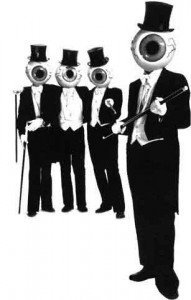 23a. [“Misery acquaints a man with __”] STRANGE BEDFELLOWS. That’s W Shakespeare, from The Tempest.
23a. [“Misery acquaints a man with __”] STRANGE BEDFELLOWS. That’s W Shakespeare, from The Tempest.- 37a. [Chic wristwear] CHARM BRACELETS. Chic? Really?
- 50a. [Adequately able] UP TO SCRATCH.
- 71a. [Simple and practical] DOWN-TO-EARTH.
- 86a. [Formal duds] TOP HAT AND TAILS.
- 101a. [Worst of the worst] BOTTOM OF THE BARREL.
Flavorful theme, not overly expansive, but admirably executed. The two biggest distractions for me were:
- The decidedly odd and archaic 67a [Old grinding stone] QUERN, prominently located just beneath the revealer in the center of the grid. Fortunately, the crossing fill made this one easy to get. I certainly welcome learning the occasional recondite word or fact from crosswords—it’s part of what keeps them interesting, after all—so my nit here is with the bold placement. On the other hand, it seems superficially to be a portmanteau of QUARK and CERN, which is rather endearing.
- 6d [101-Across stuff] DREGS. I just have a thing about non-theme fill mingling with theme material. Call it a quirk.
The rest of the grid is also strong, with longer fill including RACEHORSE, THROW A FIT, ONE BASE HIT, and WALLA WALLA, that last clued interestingly as [Tautonymic WA town]. (1) Subtle hint, using the unnecessary (as the answer is not abbreviated) abbreviation WA to nudge the solver toward the correct answer, more effectively than the polysyllablic Washington would have. (2) In scientific taxonomies, a tautonym refers to a binomial in which the genus and species are the same, such as Crocuta crocuta for the spotted hyena, which is, by the way, still most definitely not a cat, not even arguably. Since tautonym comes from Latin for “same name,” I can see how it might broadly be applied to echolalic entities such as WALLA WALLA, Bora Bora, Can-can, yadda yadda. However, the designation still seems a smidge off to me. Ah, wait! Wikiwiki to the rescue once again!
In general English, a tautonym is sometimes considered to be any word or term made from two identical parts or syllables, such as bonbon or dada. The origin of this usage is uncertain, but it has been suggested that it is of relatively recent derivation. The general term in linguistics for such double words is reduplicants.
I feel infinitesimally vindicated.
To continue, the ballast fill is strong but not particularly awe-inspiring, and it doesn’t need to be. It’s lively and has a respectably low CAP Quotient™ for a 21×21 crossword, abetted by a healthy amount of clever/playful clues.
Two ups quarked!
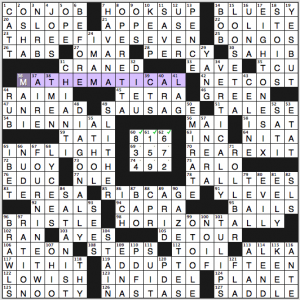
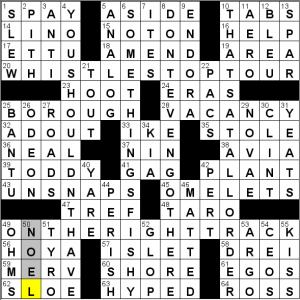
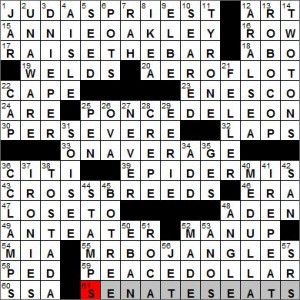
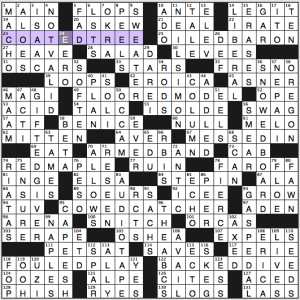
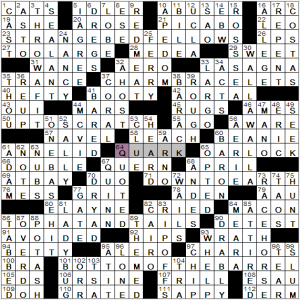
BLUESY stumped me, so I had to give up on that little corner, after putting it down and coming back to it again and again. The rest of the puzzle I enjoyed very much, though i filled the little square in the middle while I was 2/3rds done solving, and went on from there, backwards, as it were.
“Surely [Liz] has given us more squares of crossword enjoyment than any other NYT constructor.”
Enjoyment is subjective but in terms of pure count, Manny is surprisingly still about 5,000 blank squares ahead of Liz.. Interestingly, Liz leads in blocks by over 700. Apparently Manny’s one of those controversial technical achievers. Number three on that list is Patrick Berry. What a trio!
Java has been a security sieve for years and I never install it for just the reasons you cite, so I’m happy to see the Times going HTML 5, although I prefer the solver on xwordinfo. Why doesn’t the Times just use that one?
Manny leads the Shortzian-era. The pre-Shortzian era is still being counted but I suspect the all time champ may turn out to be Eugene Maleska himself. Whether all his squares led to crossword enjoyment is ANOA issue.
Maybe if the ANOA had a scrabblier consonant or two, like the IBEX or ORYX , it would get more respect and not be considered emblematic of the accursed, much and often reviled Maleska. [Ptui!] Or maybe it’s just a case of biobigotry because the ANOA is an extant species and that is it’s name.
Here’s a YouTube clip of an ANOA playing get-the-hell-outa-my-territory with a cardboard box in her enclosure at the L.A. Zoo. After her spendid performance, she comes over looking for a well-deserved treat!
Not sure what you mean with the taxonomy there. Anoas, oryxes, and ibices* are all extant species. There are two species of anoa, neither of which currently have “anoa” as the genus or species name, whereas Oryx is a genus (containing several species) and ibex are a group of similar species in the goat genus Capra, one of which is in fact C. ibex.
*(joke)
Hi Bean Counter,
The technology behind XWord Info belongs to Jim Horne. While his site is a valuable resource, Jim is no longer affiliated with The Times.
BAT MITZVAH would have been a year and a day late: its a rite at 12.
Why should anybody care how many letters a “partial” has? We’ve even seen 15 not long ago (on SAINT VALENTINE’S Day 2012).
Why? Because it’s right there in Will Shortz’s New York Times crossword specifications: “Do not use partial phrases longer than five letters.” If you gotta have a 15 with VALENTINE in it, why not STVALENTINESDAY? I did call out that 15-letter partial in my review.
Why the difference in ages for bar and bat mitzvahs? “Girls mature faster than boys”?
Yes I know, but I think it’s an arbitrary rule, contributing nothing to the enjoyment we get out of a puzzle, and I have no idea why as a solver I should be OK with a 5-letter partial but not with one of 6+ letters. STVALENTINESDAY is fine, but so is SAINTVALENTINES, and if it fits better in the grid why should I care if it’s a 15-letter partial?
“Girls mature faster” is the explanation I was told, but I don’t know how authoritative that is (I Am Not A Rabbi) — I just know that the B.Mitzvah age is 12 for girls and 13 for boys.
Many congregations are now egalitarian, and don’t have an age difference. My nieces all had Bat Mitvahs at 13.
But, if “girls mature faster” is the rationale, shouldn’t the bar mitzvahs occur at, like, age 80 or so?
And, just to clarify, is it considered a “partial” if the answer is a single word, but the constructor decided to clue it as a fill-in-the-blank because he found an interesting quote?
Henry, that would be a FITB, not a partial. Partials are incomplete multi-word answers, as I understand it.
Noam, all of the crossword “rules” are arbitrary. Why symmetrical grids? Why constraints on block count? Why no 2-letter words? Why can’t theme entries dispense with symmetry? The conventions make things more orderly/predictable/visually pretty, but do nothing to entertain the solver. Think how many funny or clever themes have never been shared with solvers simply because the letter counts don’t break down “right.”
[There doesn’t seem to be a “reply” button at level 4 so I answer here again]
Some “rules” have better raisons d’etre than others, and every rule has been broken on occasion, even the prohibition on unchecked letters. Constraints on block and word counts are proxies for the preference for open grids. But grid symmetry does nothing for me in general, and even theme symmetry is overrated: your observation “Think how many funny or clever themes have never been shared with solvers simply because the letter counts don’t break down ‘right'” looks to me like a great argument for dumping that symmetry rule, or at least for violating it much more often. In any case that fact that Will Shortz decided to impose (and occasionally overlook) a 5-letter maximum on partials doesn’t forbid Merl Reagle from using a 12-letter partial in a non-Shortz puzzle if he feels like it…
Noam, for future reference, you can “reply” at the same “level” as the previous comment (in your case, it would have been Jeffrey’s) and the reply will appear beneath the previous ones (HH’s, Amy’s) but at the same indentation.
It makes the comments more orderly/predictable/visually pretty.
[Bar Mitzvah at 80 — well there _is_ a tradition of a *second* Bar Mitzvah at 83, which is 13 plus the Biblical lifespan of “threescore years and ten” (Psalm 90).]
Fun puzzle. When I was in a summer job one year while I was in college, I learned a formula for completing a magic square of any odd number of rows. I can complete a magic square of say 15×15 faster than Dan can complete a Monday.
There are actually several ways a 3×3 can be completed, but the magic square in today’s puzzle is illustrative of how the formula works:
1. Place 1 in the center of the top row.
2. Each successive entry goes up and to the right if possible. If going up and to the right goes above the puzzle, place the next number at the bottom of the row that it would have been in if there had been a space up and to the right. If it goes off the side, place it on the other side.
3. If going up and to the right hits an already completed square, place the number immediately below the most recently completed square. If you hit a corner, put the next number in the square immediately below the corner.
If my instructions are confusing, follow the sequence from 1 to 9 in the puzzle and you will get the point of going up and to the right. Then do as I once did at work that summer (I always wondered why I didn’t get a permanent offer), complete a 101 x 101 square.
Steve
There are various ways to describe the construction of a 3*3 magic square, but (unlike 4*4 and beyond) the final diagram is unique up to the symmetries of the square, so whatever method you learned will produce today’s square (possibly rotated or reflected).
Totally agree, Noam. I was merely getting at the point that 1 has to be in the middle top to use the “up and to the right” formula in the step-by-step way I described.
Steve
I should have read the NYT first. Deb posted a link that illustrates the same formula.
Steve
NYT, easy, breezy, fun. OOLITE and TALL TEES were mysteries.
Like NDE, I don’t care how long the partial is. If it’s evocative, that makes up for a lot. And some feel like they can stand alone… e.g. YES, BUT and ST. VALENTINE’S. I can imagine people saying them without the rest of the phrase.
In the .puz version there were numbers in the first row and column of the magic square and I was thinking “Wow, how do I make this work with numbers that high?”. Congrats to Liz for her major milestone!
In response to your question, I have been using the new online version of the NYT puzzle. I like it a lot. Now, if I could only get a little bit better at solving the more difficult puzzles!
Was worried OPE was going to be some variant spelling like OPY or even OPI. Nice to be able to keep MERV and MIRV straight more than once. Did Not Finish the Puzzler which means the same guy got me two days in a row- keep up the good work, Doug!
funny how the Internet conspires to bring everyone closer! I was checking out the ’49ers’ schedule (love the apostrophe sandwich) to see whether they had a game today and ended up reading your post from top to bottom; sometimes I can’t work out the Times’ clues because so much relies on information I can’t easily or readily research.
I’m deaf. I used to be a pun-obsessed girl and as a young woman was at my sharpest; however, my priorities and crowd are now different and I don’t have many friends who parse or provide intellectual discourse. This was a fun insightful read, and I liked your joke about sign language. You’re right! Can’t write any of that–but there are actually people who want to create a written form, so check that out!–and a crossword…that was a good laugh!
You do know (just checking!) that the sign language therein is not a fingerspelled abbreviation? It’s from a physical sign: Ped Xing. Anyway, phew, a few of the wordplay answers would have been answered only peripherally (by answering everything else until I could fill in the remaining blanks, THEN laugh!).
I’ll be back!
Welcome, Beth! We’re glad you’ve joined us. Puns and parsing both encouraged here!
I was especially interested in the discussion and disagreement over the question of how to assess an extraordinary feat of construction (such as Joe Krozel’s quint stack) which may, of necessity, sacrifice some other virtues. The analogous context which has long fascinated me involves the Bach fugues for solo violin. He wrote 6 amazing sonatas and partitas (3 of each) for solo violin. Both the g Minor and the C Major sonatas include an incredible fugue. The one in C Major is a 4-voice fugue. (I call it the “London Bridge is Falling Down fugue. Listen to it on UTube, and you will see why.)
Writing a fugue for a solo violin is an astounding feat of composition (or “construction.” Think of the limitations. You have only 4 strings and one bow. The range is quite limited, since in Bach’s day about the highest note ever played was the E an octave above the e string. (Mozart extended that to the high G.) On the modern violin, only 2 of the strings can ever be sounded simultaneously, though of course the player can roll chords and figurations among the 4 strings. In Bach’s day the bow was strung more loosely, and my understanding is that it was a little easier to sound 3 strings simultaneously, or almost so. Still, under those constraints imagine how astonishing it is to construct a fugue with 4 or even 3 independent voices, which are clearly heard as such. Obviously, there is a lot of sleight of hand and ear going on since the independent voices have to be hinted at in a way which convinces the imagination that it is hearing something that can’t possibly actually be heard.
But in some objective sense, did Bach write “better” fugues for keyboard, or multiple instruments? Clarly the answer is “Yes.” (with the important qualifier “in some sense.” So how do we assess the violin fugues. l have made my own judgment that they are among the most extraordinarily intense, moving pieces of music ever written. But here is my main point: Without wanting to get into ponderous academic controversies over “intentionalist” criticism, I definitely find that knowledge and understanding of the restrictions and circumstances of the creation of these works profoundly affects — enhances and intensifies — the aesthetic experience of listening to them. So I literally and profoundly believe that these fugues are greater, more miraculous pieces, in a purely aesthetic sense, than the same notes played on a keyboard would have been.
Obviously, I am suggesting that some sort of analogous analysis might be considered in assessing puzzles like Joe Krozel’s quint stack, and I am indirectly expressing approval of his choice, though I don’t know for sure if he would have been my pick. (I consider both Barry and Doug, as well as PB I to be high on my list.)
I would beseech even those of you who have little independent interest in such matters to go listen to the g Minor or C Major violin fugues on UTube.
Thanks for reminding me of these fugues, which I’ve not heard for a while – I printed out the scores from IMSLP and played through them (on piano, not violin!). Bach does sometimes write the high G for violin (and Mozart goes a bit higher yet), and you can even find the high G in the C-major fugue; but that still extends the range only to three octaves, which is still a major limitation: for comparison, most of the Well-Tempered Clavier uses a 4-octave range (Bach’s keyboard had 4.5 octaves but he usually stuck to C-C [or B# to B# in many-sharped keys] in WTC).
Noam, thanks for your response. You’re right about the high ‘g’ in the C major fugue — I’ve played it on the piano too, and even tried it out with my feeble (HS Orchestra) violin technique when I was sure there was nobody with a mile radius to hear me. And both the Mozart 4th & 5th concertos in D Major and A Major respectively touch at least the high ‘a’. I heard A – S Mutter rehearsing them with the BSO this past summer. What an extraordinary experience.